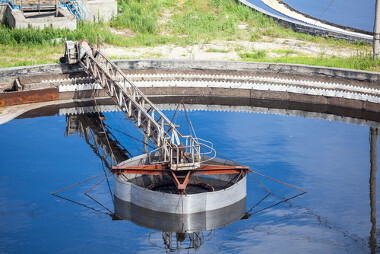We are well aware that water is essential for the maintenance of life on our planet and is essential for the development of society. However, as shown in the text “Types of water pollution”, this water resource is being contaminated in different ways, which can transmit diseases such as cholera and typhus.
Regardless of their origin, whether they come from rivers, lakes and dams, or from underground water tables, all these water sources are prone to pollution. That's why, before being sent to our homes, the water from these springs first passes through the Water Treatment Plants (ETAs).
It is worth emphasizing the difference between the ETAs and the ETEs (Sewage Treatment Plants). As stated, in the ETAs, the treatment carried out is the fresh water found in nature that contains organic residues, dissolved salts, heavy metals, suspended particles and microorganisms. These treated waters are sent to homes, industries and other establishments to be consumed. In the ETEs, the treatment done is residential and industrial sewage, and, after being treated, this water can be introduced again into rivers and lakes without causing great environmental impact as it would if it were dumped directly without the treatment.
One of the steps in the water treatment process at the ETAs involves the coagulation and the flocculation. In these waters that will be treated there are impurities whose particles are colloidal, that is, they have an average diameter between 1 and 1000 nm. Because they are small, they do not settle (they do not settle on the bottom of the container) under the action of gravity.
Therefore, it is necessary to add to the water chemical coagulants. Generally, here in Brazil, the coagulant used is the aluminum sulphate (Al2(ONLY4)3). But there are other chemical agents that can be used with this same function, such as iron(III) salts or yet organic polymers. These coagulants are insoluble in water and generate positive ions (cations) that attract negatively charged impurities in the water.
Chemically, we can explain it like this: aluminum sulfate generates the following ions in water:
Al2(ONLY4)3 → 2 Al3+ + 3 SO42-
A smaller part of Al cations3+ neutralizes the negative charges of the impurities present in the water, and most of them interact with the hydroxyl ions (OH-) from water, forming aluminum hydroxide:
Al2(ONLY4)3 + 6 H2O → 2 Al(OH)3 +6 H+ + 3 SO42-
This aluminum hydroxide is a positively charged colloid that neutralizes negatively charged colloidal impurities in the water. Note that there is an excess of H+, which makes the medium acidic and can prevent the formation of aluminum hydroxide. Therefore, with the coagulant, some compound that increases the pH (alkalinity) of the medium is added to the water, such as calcium hydroxide bases (Ca (OH)2) and sodium hydroxide (NaOH), or a basic salt such as sodium carbonate (Na2CO3), known as a soda.
Thus, the polluting particles are destabilized and agglutinate, which facilitates their deposition or agglomeration into floccules. We can say then that coagulation is a chemical process used to destabilize colloidal particles.
In the next and complementary part, called flocculation, the water is shaken strongly for about 30 seconds by a mechanical stirrer, as shown in the figure below, in order to increase the dispersion of the coagulant. Then the system is slowly agitated, allowing the contact between the particles.

Mechanical stirrer used in water flocculation
These floccules formed are then forwarded to another stage of treatment, which is sedimentation and decantation, where they settle on the bottom of the tanks and are collected. The text
Separation of mixtures by decantation shows what this physical process is about.
The coagulation/flocculation process is considered a type of tertiary wastewater treatment, as it employs physicochemical techniques to remove specific pollutants. Unfortunately, this is a technology to transfer pollutants from water to another place, as they are turned into solid waste, but the pollution is not destroyed.
By Jennifer Fogaça
Graduated in Chemistry
Source: Brazil School - https://brasilescola.uol.com.br/quimica/coagulacao-floculacao.htm
